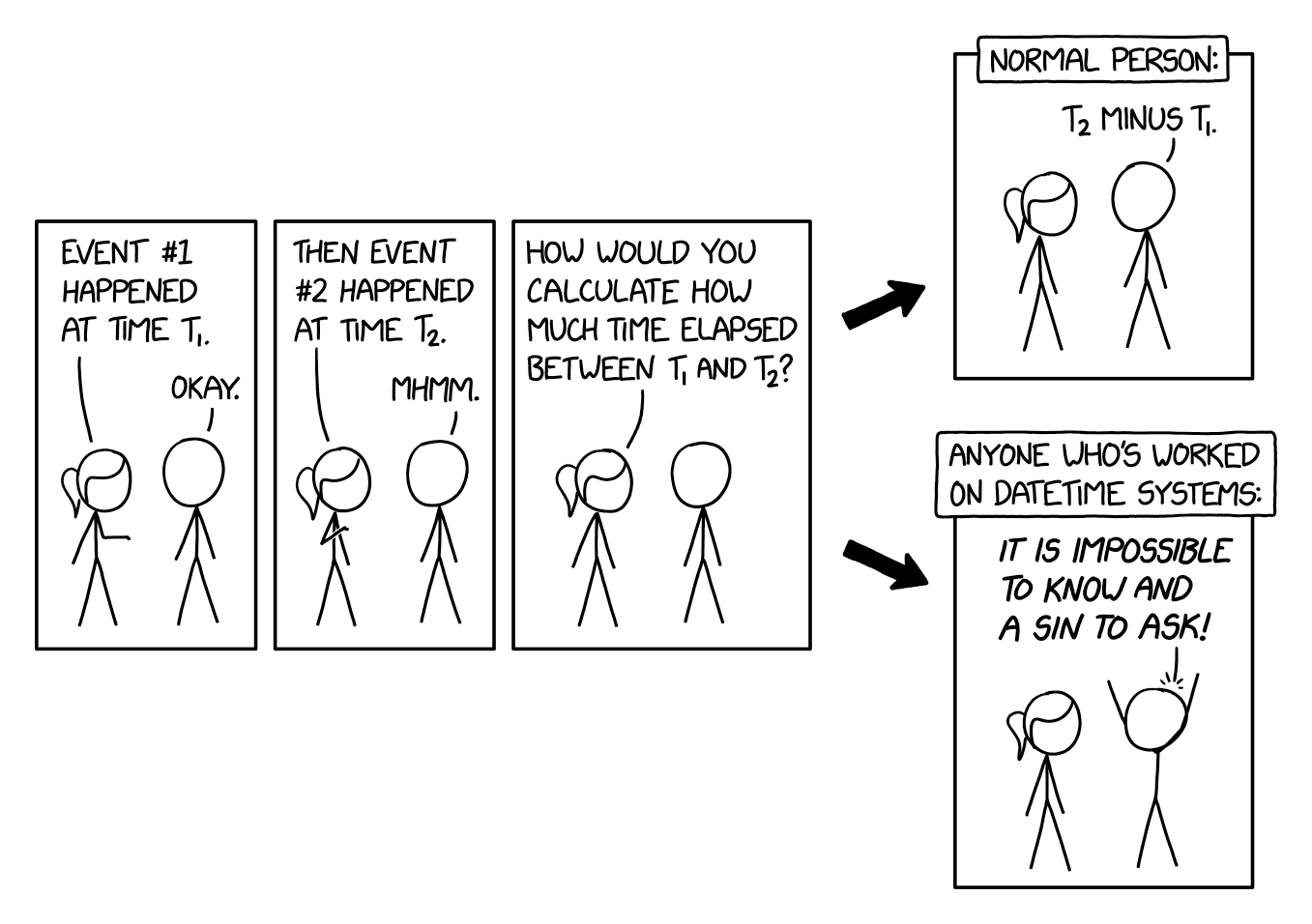- Ok, but the time on the server clock and time on the client clock would never be different by a matter of decades.
- The system clock will never be set to a time that is in the distant past or the far future.
Does this come up? I feel like if you’re doing retrocomputing you assume a certain level of responsibility for your software breaking.
- Ok, but the duration of one minute on the system clock will be pretty close to the duration of one minute on most other clocks.
- Fine, but the duration of one minute on the system clock would never be more than an hour.
- You can’t be serious.
You can’t be, can you? Ditto on that being the user’s problem. My thing also isn’t portable onto Zeus Z-2 or a billiard ball computer you built in your garage.
There’s some weird shit in the crowdsourced ones. I don’t even know where to start.
You heard of standby and the likes? What do you recon that does to programs calculating with time in that exact moment?
I… Actually don’t know.
The real time clock continues to move in real time under reasonable conditions. If it’s in a weird year it’s either because you’ve decided to run a disk you found in a cave, left by the Ancient Ones, or you’re cheating at Animal Crossing.
I’m a little unclear on how the rest of the clocks typically work together. If your program is drawing from one that gets stopped for a while, I guess yeah, a minute could totally be weeks long, and I’m in the picture as a falsehood believer.
if that person who wrote all these could provide examples for why literally any of them are wrong instead of just resorting to the standard “falsehoods programmers believe” fare of “you believe this? ha. it is wrong. therefore I am smarter than you” I would very much appreciate it
OMG, it’s so trivial. What you do is when T2 happens you send an atomic clock back in time to T1 and start counting till T2 happens again. If T1 and T2 happen in different locations you send two entangled clocks and collapse the state on T2 clock when the event happens measuring the exact moment on T1. How is this an issue?
The past is the past. Everything that happened before time
t_nowshould be set toInf. I thank you for your ears.Or anyone who has worked with general relativity
Actually, while mathematically heavy, it’s easy to measure in GR, assuming you’ve got a metric solved (If you don’t, you’re fucked. That shit is intractable to the point where you can name every exact solution on one page, and inexact solutions can just be lies) However, you may have to ask additional questions about what sort of time you want, which probably stems from why you need it.
T2 - T1 = 'a while'I mean, as long you only need the delta in milliseconds it’s easy. Just count the milliseconds from 1970 to the event. The problem starts when you want to have a human readable representation.
It’s calenders they suck, not time.
Well… unless you measure the number of [milli]seconds using something like time_t, which lies because of leap seconds. I.e. even such a seemingly simple interface, in fact, includes a calendar.
Re: The mouseover text, is there a standard frame of reference for really general space stuff? I propose a frame comoving with the CMB and reaching the center of the Earth at Epoch 0 if not.
Sounds like a distributed systems problem. While the time between events could be impossible (can’t guarantee clocks are synchronized) you can use a logical clock to have causaul ordering.
I feel like this is a solved and simple problem as long as there are no relativistic effects. Just make sure t1 and t2 are represented as seconds since a known reference time, e.g. Unix epoch, and make sure that measure is accurate. You don’t need to bring the Gregorian calendar into it, use TAI represented as an integer.
Until you need to decide how many months are between t1 and t2, and then all answers are wrong.
To do that you first need to choose a calendar and a time zone, then convert to that representation. It can be done, but you need a good implementation that understands the entire history of what has transpired w.r.t. to date conventions in that location and culture. For timestamps in the future it is impossible to do correctly, since you can’t know how date conventions will change in the future.
However, I should add that as far as mathematical operations go, calculating the number of months between t1 and t2 is an entirely different thing than the duration of time that passed between those timestamps. Even if it is expressed similarly in the English language, semantically it’s something else. It’s like asking “how many kilometers did your car go” vs “how many houses did the car pass on the way”.
.net has a timespan data type specifically for this sort of thing.
After using it, coming to python and not having a super easy way to work with dates is a pain.
But DateTime in dotNet have horrible timezone support. It’s essentially either local timezone, not timezone or utc. And the utc part is somewhat rough. There’s some datetimeoffset and the like, but they too just don’t let working with timezones be easy.
I’m guessing it’s not alone. Every time format should come with a distance function and order function, or equivalent. If you have a life, that could mean something like subtraction.
Unfortunately, “should” isn’t always enough. Optimally there’s also type structure to the return of the function so you can’t mix up seconds and days, or calendar and (one of the) standard length days.








